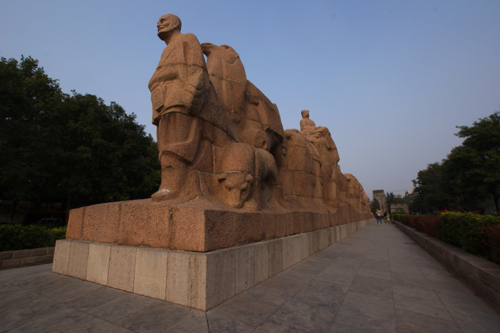Our introduction to Xi’an, the start of the famed Silk Road was summed up by this quote from our guide Maggie.
“To see tens of years of history visit Shanghai. To see hundreds of years of history visit Beijing. To see thousands of years of history visit Xi’an.”
Naturally our first stop in Xi’an was the Terracotta Warriors.
Over 7,000 have been unearthed in the area around Emperor Qin Shihuang’s tomb. It is believed that here are many more still buried there.
They were discovered by a local farmer, Mr Yen, in 1974. Since that time he has gone on to become a celebrity. He even has his own store at the site, where he signs books, postcards or whatever else you might care to buy.
Even taking a snap of Mr Yen will cost you.
The bodies of the warriors were made in casts while the hands and heads were crafted individually, making each solder unique.
Emperor Qin Shihuang had a vision for China and fulfilled it in a brutal and bloody manner. He united the Chinese, through a series of wars lasting 16 years. He wasn’t all bad as he introduced a unified system of weights and measures plus a common currency.
The Emperor, like so many ancient and modern leaders, wanted his power to last forever. To this end he built his tomb on such a grand scale that he included an army to help him keep his power in the afterlife.
The Terracotta Warriors are that army.
The average size of a flesh and blood warrior in those days was 1.5m, his warriors were made to be 2m tall. Emperor Qin Shihuang wanted to make sure he would never be beaten, living or dead.
In the afternoon we hired bikes for a ride around the 14.5 km of the ancient city wall. It was very flat but with the cobblestones, a bit like the Paris to Roubaix.
At Maggie’s insistence we bought an evening entertainment package that consisted of a dumpling dinner and cultural show.
The dumplings were shaped according to what was inside. We had piglets, fish, lotus flowers and tomatoes. There were some with no real shape, so I was a bit sceptical about their filling.
My favourite act of the cultural show was a percussion group, playing a variety of drums, cymbals and bells.
The next day we visited the Big Wild Goose Pagoda and the Shannxi History Museum. The Big Wild Goose Pagoda is made from stone and was originally constructed in 652, during the Tang Dynasty. Today it has a very distinctive lean that was caused by an earthquake in 1556.
The Shannxi History Museum, like all Chinese tourist attractions, was crowded. Here the locals were taking snaps of everything in museums – what do they do with all those photos?
We wanted to get a shot to celebrate the start of our Silk Road adventure, so after much searching Maggie and the driver found the the Silk Road Monument that Thea discovered existed just outside the city walls. It was a large sandstone sculpture depicting a camel train, heading west, just like us.
In the afternoon of our second day we visited Muslim Street and the Great Mosque of Xian.
Muslim Street, as the name suggested is the area where most of Xi’an’s Muslim community live. It’s a very crowded street full of food, goods of all variety and souvenirs for the tourists.
There were dozens of food stalls and fast service restaurants.
We had a quick meal in one of them before heading off to catch the train to Lanzhou.
I ordered food from the front counter and the service was so fast that the food was already on the table by the time I got back to my seat.
Within the Muslim Street precinct is the Great Mosque, which bares little resemblance to other mosques we have visited. It’s designed totally in a Chinese style with pagodas, gates, relief sculpture and calligraphy. Representational art is rare in Arabic mosques, with the only decoration consisting of quotes from the Koran.
The overnight train to Lanzhou was an experience.
We had a ‘soft sleeper’ which was a cabin with four bunks, which we shared with a Chinese couple.
The bed was comfortable enough however the train ride was full of bumps, rattles, jerks and frequent stopping. I have know idea how many carriages were hitched and unhitched during the night.
Music and a constant babble in Chinese was piped into our cabin until 11pm and then resumed again at 5.30am.










